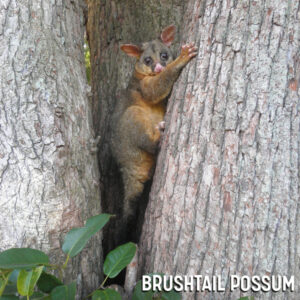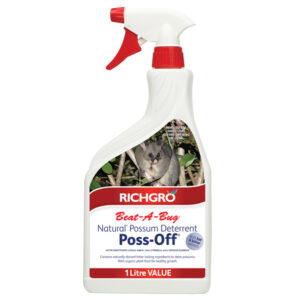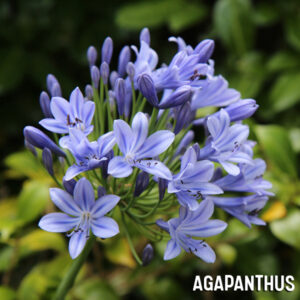Possum-proof your garden: How to keep possums away from your plants
According to our records, “how to deter possums from my garden” is a really popular internet search. You’ve probably landed here because you’re having possum issues and have turned to Google for help.
Possum populations have exploded in the past decade or so, as these furry marsupials find themselves well-suited to suburban life. With their agility and adaptability, they are able to get just about everywhere to dine out in our gardens, even reaching plants on upper-storey balconies.
Need advice on how to possum-proof your garden? Read on!

Types of possum
There are two species of possums that feed in gardens. Brushtails are the big possums with black furry tails and a ghoulish grunt. A mature brushtail can weigh up to 2.4kg, which is why they do so much damage in the garden. They are very territorial and may live in roof spaces, in hollows in trees or in hedges.
Much smaller and more delicate are ringtails. These sweet possums are much smaller than the brushtails (800g in weight) with a delicate, curled, bare tail (ringtail) that helps them negotiate the garden. They live in homes called ‘drays’ made up of a loose and messy collection of twigs, often tucked into shrubs. While they are smaller and sweeter than brushtails, they also eat garden plants. However, they don’t always cause as much damage as the big brushtails, and are often tolerated in gardens.
How to keep possums away from your garden
There are many folk remedies thought to deter possums from gardens. Some of these include using spotlights, hanging CDs, lapsang souchong tea and blood & bone. None of these solutions have a lasting or reliable effect.
There are two main methods to successfully protect plants from possums. The most important is to erect physical barriers, which are then backed up with deterrent sprays.
 Barriers
Barriers
Physical barriers can range from possum-proof fencing around the perimeter of a property to the use of covers for individual plants. Possum-proof fencing is made by constructing a 2.5m-high wire fence that’s topped with a length of floppy wire that makes it impossible for possums to climb into the property. The wire flops outwards, making it hard for the possum to get over it.
This works well for those in rural or semi-rural areas establishing a new garden. The fence line needs to be kept clear of bushes and overhanging branches that could provide another access route.
Existing fences that offer a ready-made possum highway can be made difficult to access with spikes fitted to the top of the fence. Again, you will need to keep overhanging branches away from the fence lest you unwittingly make it easier for possums to access your plants!
If a possum-proof fence isn’t possible, consider growing productive plants such as fruit trees and shrubs inside purpose-built wire fruit cages. These will also protect crops against birds and bats, which can also cause damage.
Protect large, freestanding trees by encasing several metres of the lower trunk in metal or plastic sleeving. Sleeves prevent the possum from climbing into the tree from the ground. For it to be effective, the tree needs to be away from other trees, fences or walls that could allow a possum to leap into the branches. This remedy can be very successful for trees such as maples or magnolias that are very appealing to possums. Examine tree trunks for scratch marks to see which trees they are accessing.
Smaller plants can be protected with their own purpose-made covers. This technique is ideal for plants grown in containers or young plants. Covers can be made from shadecloth or wire and placed over the plants at night, then removed in the morning. A wire waste paper basket can also be a very handy overnight barrier. This night cover is a handy way to protect edible plants such as herbs, dwarf citrus trees and strawberries along with roses, as possums are nocturnal so feed at night.
For vegetable growing, invest in elevated garden beds with a wire, plastic or shadecloth cover that can be lowered to protect the crop overnight. This type of lidded growing system also protects from other pests.
To protect a new plant in the garden, make a semi-permanent wire cover around and over the plant. It needs to be sturdy enough to withstand a possum climbing onto it in the hope it can reach the plant through the wire. Once the plant begins to grow, the cover will need to be removed. By this stage the plant should hopefully be mature enough to avoid being damaged.
 Protective sprays
Protective sprays
Repeated feeding by possums causes a lot of damage to plants and can even kill them, especially when the new growth is constantly eaten off. In this situation, protective sprays can help. There are several commercial products available including D-Ter and Poss-Off, which are applied to growth (such as new shoots, buds, leaves).
These are a deterrent and not a poison, so they are not harmful to the plants, the possums or pets. They need to be applied frequently as they can be diluted or washed off during rain, watering or even after heavy dew. Once the new growth has matured or the bud has opened, it should no longer be appealing to the possum so the spray can be discontinued until the next flush of growth occurs.
 Plants to deter possums
Plants to deter possums
While there are plants that possums love – especially roses, maples and magnolias – they will eat just about anything. Occasionally a plant will appear to be possum-proof as it is ignored by possums, often for years, but it may be eaten when a new possum comes into the area or the animals are extra hungry. But, if you discover some plants that they ignore that grow well, plant more of them! Plants that aren’t touched in my garden include acanthus, agapanthus, box and lavender.
One handy technique is to include some sacrificial plants in the garden. Coppiced gum trees, for example, provide a constant supply of new foliage for the possums to browse. To coppice a tree, just cut it back to its base and let the new growth come up as a multi-branched shrub. As it becomes too tall, cut the tree back again.
Possum removal
Many gardeners regularly solve their possum problem by trapping and removing the animal. There are restrictions around trapping and relocating possums, so it is important to keep within local guidelines. Often another possum simply moves in, so far from solving the problem, it may make it worse.
It may sound counter-intuitive, but a better approach is to tolerate the possum you have. You could even build it a possum box in a tall tree. As possums are territorial, it will keep away other possums, and you already know its eating habits!

